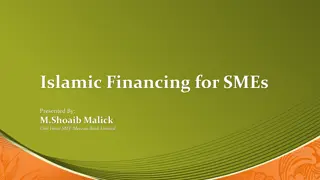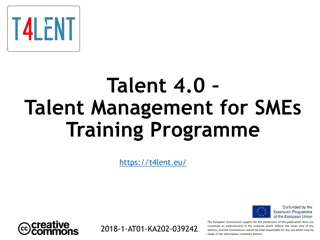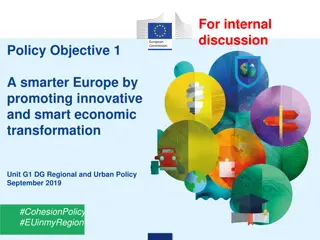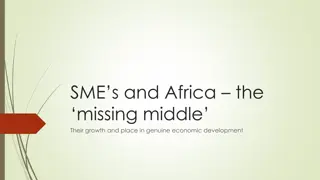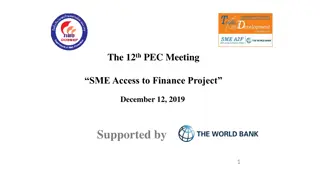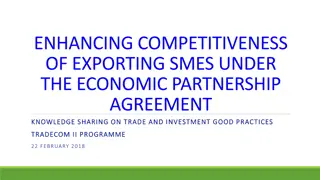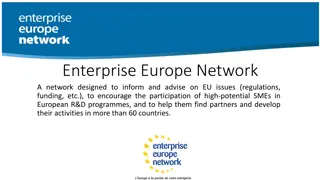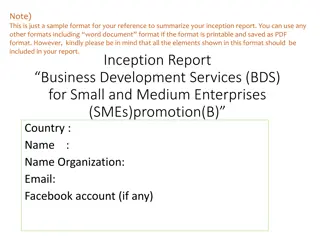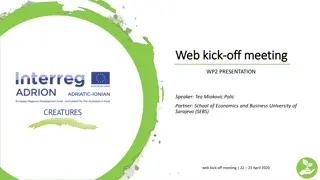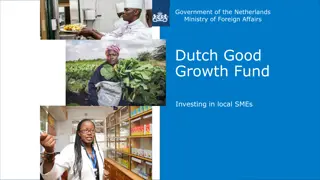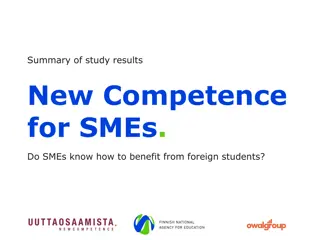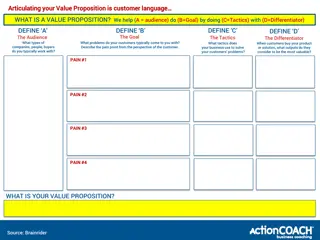Developing International Strategies for SMEs
SMEs face unique challenges when expanding internationally, from sensitivity to external factors to limited resources. Market entry modes must be carefully selected based on factors like host country knowledge and context-specific resources. Understanding strategic alternatives, evaluating choices, and implementing feedback processes are critical for successful internationalization strategies.
Uploaded on Feb 25, 2025 | 0 Views
Download Presentation

Please find below an Image/Link to download the presentation.
The content on the website is provided AS IS for your information and personal use only. It may not be sold, licensed, or shared on other websites without obtaining consent from the author.If you encounter any issues during the download, it is possible that the publisher has removed the file from their server.
You are allowed to download the files provided on this website for personal or commercial use, subject to the condition that they are used lawfully. All files are the property of their respective owners.
The content on the website is provided AS IS for your information and personal use only. It may not be sold, licensed, or shared on other websites without obtaining consent from the author.
E N D
Presentation Transcript
Learning Objectives Understand the necessary steps to develop an international strategy Be able to evaluate different strategic alternatives Understand the relevance deciding for a strategic alternative for Internationalising 2
Steps in Developing International Strategies 1. Mission and Objectives 2. External Analysis 3. Internal and Competitive Analysis 4. Strategy Alternatives 5. Strategic Choice, Implementation, Feedback, and Control 3
Step 1: Establish Mission and Objectives Purpose Values Directions 4
Steps in Developing International Strategies 1. Mission and Objectives 2. External Analysis 3. Internal and Competitive Analysis 4. Strategy Alternatives 5. Strategic Choice, Implementation, Feedback, and Control 5
Step 4: Evaluate International Strategic Alternatives Pressure for Local Responsiveness Pressure for Global Integration Alternative Strategies 6
Some Research about SMEs SMEs have a high level of sensitivity to external influences (Cheng & Yu, 2008; Krishna Erramilli & D Souza 1995), entry mode that allows them to deal effectively with host country risks SMEs have limited financial and personnel resources (Brouthers & Nakos, 2004; Nakos & Brouthers, 2002) SMEs have different ownership structure and management characteristics (family-owned and/or ownermanaged) (Cheng, 2008; Pinho, 2007) Family-owned firms are often less willing to share control with a partner (Fernandez & Nieto, 2006).
Market Entry Mode influenced by: Host country knowledge: Acquiring takes time, costly and inefficient, and leads to mistakes (Dierickx & Cool, 1989) that are more difficult for an SME than a larger firm to bear. Context-specific resources: expensive to acquire and time costly. could be obtained from network, relationships, distribution channels and even government authorities when formal institutions are weak (Peng & Heath, 1996). Legitimacy: SMEs with small resources and a lack of proven products on the market lack legitimacy and attractiveness for collaboration.
SMEs How to expand? biggest chances: SMEs operating in sectors that offer innovative products or services that provide a value for which clients in international markets are willing to take the risk to order or to partner Importance of networks and local partnership Access and ownership of resources is crucial Cooperative entry modes recommended Khalil, 2017
The Global Organisational Challenge Increased complexity and differentiation -Greater level of internal and external complexity - Numerous differences include economic development, language, political system, cultural norms and values, etc. - Increasing needs for greater response to local preferences Integration -It is necessary for a global organisation to reap the benefit of economies of scale, economies of scope, and low-cost production Knowledge transfer -International environment offers opportunities for learning and the development of diverse capabilities 10
Global Integration What does global integration mean? The firm gains comparative advantages by integrating globally distributed activities into its value chain Implications : Downstream activities are often country-specific Firm s reputation Brand name Service network Upstream activities are more often subject to global competition A firm can realise integration benefits more easily on the level of upstream activities Downstream vs. Upstream along value chain Upstream: decoupled from where the customer is located Downstream: more related to the customer 11
What is upstream, what is downstream? Source: Wieland, Andreas; Wallenburg, Carl Marcus (2011): Supply- Chain-Management in st rmischen Zeiten. Berlin, p.8. 12
What does Global Integration mean? When designing the value chain, two dimensions are of central significance: Configuration of the value chain: Where and in how many places in the world is a value chain activity preformed? dispersed: many locations per activity concentrated: one location per activity Coordination of the value chain: How closely are the different activities of the value chain coordinated with each other? high low coordination: centralised decisions coordination: decentralised decisions 14
Design Options of the Value Chain high Coordination Activities low Configuration dispersed concentrated Source: Porter, M. E. (1986), Changing Patterns of International Competition, in: California Management, Review, Vol. 28, No. 2, p.9-40. 15
Conditions for Global Integration Generating economies of scale with regard to every activity Realising learning effects with regard to each activity Realising relative competitive advantages by choosing a concentrated location Realising coordination advantages by centrally coordinating the locations that are interconnected, e.g. with regard to R&D and production 16
Local Responsiveness What does local responsiveness mean? A firm s strategy is closely adapted to the needs of the foreign country Subsidiaries are granted a margin of independent decision-making that is used to adapt the strategy to the requirements of the nondomestic market Conditions in the foreign markets differ so strongly from the ones in the domestic market that central decision-making would be inefficient The main driver of local responsiveness is the so-called liability of foreignness 17
What does Local Responsiveness mean? Liability of Foreignness Differences in languages and the ways people communicate are not exclusive factors Environmental pressure and opportunities in the domestic market shape skills, structures, practices, and routines of companies Differences Constant exposure to environment and functioning effectively and efficiently within the specific domestic social, cultural, economic, and legal environment The same process takes place on behalf of the customers Consequently, a new firm that enters the market is systematically, compared to a domestic firm, at a disadvantage To overcome this disadvantage it is necessary to accept high adjustment costs 18
What does Local Responsiveness mean? Adaptation takes place with regard to: Country-specific technical standards Distribution channel Design/Taste Product presentation Organisational structure Services 19
Design Options of the Value Chain high Activities Coordination low Configuration Source: Porter, M. E. (1986), Changing Patterns of International Competition, in: California Management, Review, Vol. 28, No. 2, p.9-40. dispersed concentrated 20
Conditions for Local Responsiveness The decision to buy depends strongly on idiosyncratic motivations Cultural factors play a central role Languages Ethnic groups, religions Different values, norms Trust is tied to the feeling of being part of a group Social networks are crucial for transactions 21
Integration/Responsiveness Matrix As a matter of fact, not all of the firms pursue the same strategy with regard to the choice between integration and adaptation Some firms tend to focus on: Worldwide standardisation ( global integration ) and others more on Adaptation to local needs of the host country ( local responsiveness )
Alternative Strategies Local Responsiveness low high Global Integration 1 Global Strategy 3 Transnational Strategy Most challenging high 2 Home-Replication 4 Multi-Domestic Strategy low (Bartlett & Ghoshal, 2002).
1 Global Strategy 3 Transnational Strategy Cell 1: Global Strategy 2 Home-Replication 4 Multi-Domestic Strategy Integration of all of the firm s activities into an overall system (high level of central decision-making, concentrated locations regarding activities) Corporate objectives with regard to the world trade are formulated without specifically paying attention to local needs Standardised mass production to reap benefits of economies of scale Parent company and subsidiaries as integrative parts make worldwide division and specialisation of labour possible The Global Strategy is the counterpart of the Multi-Domestic Strategy (cell 4) 24
1 Global Strategy 3 Transnational Strategy Cell 2: Home-Replication Strategy 2 Home-Replication 4 Multi-Domestic Strategy Low level of integration, low level of local responsiveness Often: internationalisation at an early stage Firm focuses on the domestic market The firm s objective is to maintain the domestic company by realising profitable foreign business activities through exports The firm s inability of being sensitive to country-specific differences The implementation of domestic management concepts in the foreign subsidiaries without modifying them "Dieses Foto" von Unbekannter Autor ist lizenziert gem CC BY-SA 25
1 Global Strategy 3 Transnational Strategy Cell 3: Transnational Strategy 2 Home-Replication 4 Multi-Domestic Strategy Tries to balance the concern for global cost advantages with the need for local responsiveness and global learning Based on globally issued frameworks, the concepts are modified locally The firm has understood the problem of strategies lacking adaptation and tries to be sensitive to country-specific differentiation advantages "Dieses Foto" von Unbekannter Autor ist lizenziert gem CC BY-SA-NC Strategic components of a transnational firm are: global competitiveness, multinational flexibility, and a worldwide ability to learn that is guaranteed by the global network of activities 26
1 Global Strategy 3 Transnational Strategy Cell 4: Multi-Domestic Strategy 2 Home-Replication 4 Multi-Domestic Strategy Multi-domestic firms are economically active in various national markets The objective is to guarantee the international corporate success Subsidiaries are granted a margin of independent decision-making to adapt the strategy to the needs of the foreign market in question They act as de facto autonomous national firms, as the conditions of the new foreign market differ so greatly from the ones of the domestic market, that central decision-making would be highly inefficient The parent company acts as a holding company "Dieses Foto" von Unbekannter Autor ist lizenziert gem CC BY-SA 27
Transnational Strategy as an Emergent Strategy for Globalisation Explicit recommendation from Bartlett and Ghoshal (1989): Transnational strategy as strategy for globalisation Balance the concern for global cost advantages with the need for local responsiveness and global learning Adapt globally issued frameworks to local needs Be sensitive to country-specific differentiation advantages Take advantage of strategic competencies global competitiveness, multinational flexibility and worldwide ability to learn that is guaranteed by the global network of activities For the successful implementation of this strategy it is decisive for the subsidiaries to be capable of managing these tasks 28
Strategic Alternatives Video
Homework: Strategy Questions on Internationalisation of SMEs 1. Watch the following videos : Stories of entrepreneurs on the INTENSE website (http://intense.efos.hr/index.php/youtube-channel/) 2. For each entrepreneur compile a short story including strategic information provided and open questions that remain concerning the international strategy of the company 3. Try to determine the strategic alternative each company seems to follow
Summary Companies face two contradicting pressures: pressure for local responsiveness and pressure for global integration The strategic choice on which pressure to follow determines the international strategic alternative A transnational approach tries to accommodate both pressures and is hence the most complex strategy
Learning Objectives Understand the necessary steps to develop an international strategy Be able to evaluate different strategic alternatives Understand the relevance deciding for a strategic alternative for Internationalising 32
List of References Bartlett, C. A., & Ghoshal, S. (1989). The transnational solution. Boston: Harvard Business School. Bartlett, C. A., & Ghoshal, S. (2002). Managing across borders: The transnational solution. Harvard Business Press. Bartlett, C. A., & Ghoshal, S. (2002). The transnational and beyond: reflections and perspectives at the millennium. In Advances in Comparative International Management (Vol. 14, pp. 3-36). JAI. Brouthers, K. D., & Nakos, G. (2004). SME entry mode choice and performance: A transaction cost perspective. Entrepreneurship theory and practice, 28(3), 229-247. Chandler, A. (1962). Strategy and Structure, Cambridge, MA: MIT press. Cheng, H. L., & Yu, C. M. J. (2008). Institutional pressures and initiation of internationalization: Evidence from Taiwanese small-and medium- sized enterprises. International Business Review, 17(3), 331-348. Daft, R. L., Murphy, J., & Willmott, H. (2014). Organization theory and design: an international perspective. Andover: Cengage Learning. Dierickx, I., & Cool, K. (1989). Asset stock accumulation and sustainability of competitive advantage. Management science, 35(12), 1504-1511. Ferna ndez, Z., & Nieto, M. J. (2006). Impact of ownership on the international involvement of SMEs. Journal of international business studies, 37(3), 340-351. Ghoshal, S., & Bartlett, C. A. (1990). The multinational corporation as an interorganizational network. Academy of management review, 15(4), 603-626. Griffin, R.W.; Pustay, M. W. (2013) International Business, Pearson Education Limited.
List of References Harzing, A. W. (2000). An empirical analysis and extension of the Bartlett and Ghoshal typology of multinational companies. Journal of international business studies, 31(1), 101-120. Khalyd. M. (2017), Expansion of SMEs into Emerging Markets, Inaugural lecture given by Dr Mohammed Khalil, marking his professorship of International Trade Management at the Faculty of International Business and Communication, Zuyd University of Applied Sciences, on Friday 17 February 2017 Krishna Erramilli, M., & D Souza, D. E. (1995). Uncertainty and foreign direct investment: the role of moderators. International Marketing Review, 12(3), 47-60. Nakos, G., & Brouthers, K. D. (2002). Entry mode choice of SMEs in Central and Eastern Europe. Entrepreneurship theory and practice, 27(1), 47-63. Pinho, J. (2007). The impact of ownership: Location-specific advantages and managerial characteristics on SME foreign entry mode choices. International Marketing Review, 24(6), 715-734. Peng, M. W., & Heath, P. S. (1996). The growth of the firm in planned economies in transition: Institutions, organizations, and strategic choice. Academy of management review, 21(2), 492-528. Porter, M. E. (1986), Changing Patterns of International Competition, in: California Management, Review, Vol. 28, No. 2, p.9-40. Wieland, Andreas; Wallenburg, Carl Marcus (2011): Supply-Chain-Management in st rmischen Zeiten. Berlin, p.8.






